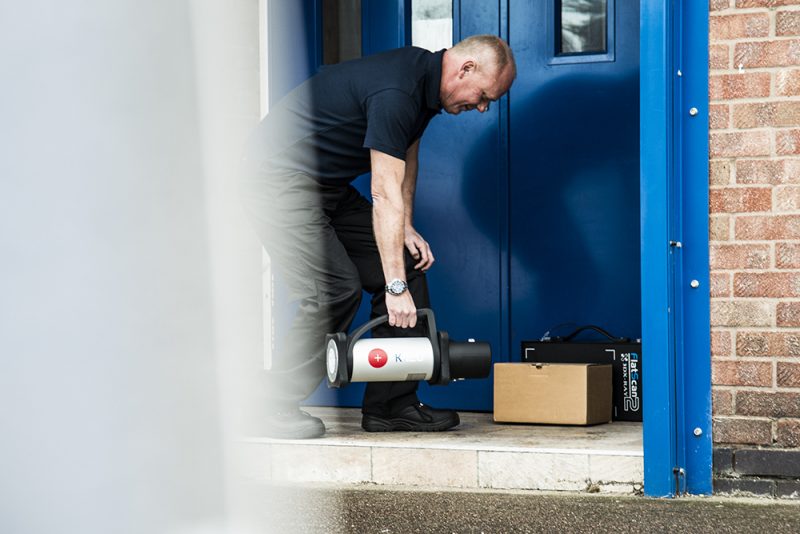
Easing disruption during high risk security alerts
10 January 2010
Nick Fox, CTO of 3DX-RAY, explains how effective scanning technology can minimise the disruptive impact of suspect packages in airports
In the last ten years there have been a series of incidents involving suspect packages at UK airports. Whether they were hoaxes, or genuine threats, there have been incidents at most of the UK’s biggest airports including Gatwick, Luton, Bristol, Heathrow (2000 people were evacuated from Terminal 2 in 2006) and most recently in March at Leeds-Bradford airport. When dealing with these situations it is clearly essential to establish the exact contents of the package quickly and authoritatively with minimal exposure to risk. In particular it is vital to confirm whether a package is a hoax or a genuine threat. Once the contents are known, the authorities are far better placed to judge their response.
Therefore the scanning equipment used to detect whether a package is a threat or not plays a pivotal role in the handling of these high risk security situations. However, the question is whether current solutions are doing enough to speed the detection of threats in suspect packages, increase the safety for security staff and ultimately ease the disruption caused by these security alerts. When it comes to implementing the technology there are several factors that have to be addressed in order to deliver a truly effective solution.
Technological benefits
The two important and inter-linked issues then are the time taken to identify the specific threat and the exposure of individuals to risk whilst ascertaining that threat. Having the appropriate equipment for scanning suspect packages is therefore crucial. The first technological step is to have as large a scanning plate as is feasible. If the imaging plate is too small there are two issues – a small imaging plate means it is not possible to scan a package in one go, delaying identification of the potentially dangerous contents. It also makes it necessary to undertake more than one scan, putting disposal operatives at direct risk for longer.
The second technological issue, as with all scanning equipment, is the image quality. For situations involving suspect packages it is necessary to have the highest image quality possible. This is crucial in being able to confidently establish the contents of a package. This means that any scanner has to be able to see inside even very dense objects and provide clear, precise images. This is becoming more and more important as it is now more likely that a device will be ‘dirty’ – i.e. surrounded by some sort of chemical, biological, radiological or nuclear material.
Real-world experience delivering better technology
In terms of mitigating risk, it is also important for suppliers of scanning equipment to be aware of customer experiences when dealing with suspect packages. For instance, feedback from field operatives shows that it is extremely common for suspect packages to be left by a wall, or up against an immovable surface. As a result, bulky scanning equipment is often ineffective – worse, it can actually increase the risk in an already dangerous situation. Bulky equipment cannot be slipped behind a package without having to move it. If a package has to be moved, then obviously there is an added element of risk for those involved in the operation as they will have to move the package before being able to scan it. A slim line scanning panel that can easily fit behind a package, even when next to a solid surface, is the obvious solution.
Current solutions most commonly deploy a fluoroscopic scanning system. However, this type of device suffers from two weaknesses: a small imaging area and low image quality. As a result, extra time may have to be taken to complete multiple scans for large packages, causing significant delay to an airport’s operations. Moreover, the scans may not be clear enough, requiring more time to be spent analysing the scans to be confident of the exact contents. Consequently such systems are a long way from being the most suitable, quickest or safest scanning technology for this application.
3DX-RAY has developed the FlatScan-TPXi specifically for scanning suspect packages in situ. It not only offers very high quality images in order to look into dense objects, it also has a large imaging plate – enabling the emergency services to scan most bags in one go. Allied to this is advanced software analysis enabling the scans to quickly deliver useable and reliable results. The British Transport Police has deployed the FlatScan-TPXi and state that it is possible to resolve such incidents in 20 minutes using 3DX-RAY’s product. If deployed in airports this could significantly decrease the delays caused by the discovery of a suspect package.
In addition the FlatScan-TPXi has also been designed with a slim profile, reflecting the real-world needs of security operatives. Moreover, it is also possible to deploy the FlatScan-TPXi remotely, using a robot – removing the need for individuals to be put at risk unnecessarily.
Specialised solutions for high risk situations
Key to delivering swift resolution, improving safety for everyone and minimising disruption, is being able to provide equipment that meets the demands of real-world security scenarios. The best way to achieve this is through actual experience in dealing with customers on the front line and also paying close attention to their requirements and the specific challenges that each agency involved has to cope with.
When dealing with suspect packages in public spaces, safety is of course paramount. However, that should not prevent all parties involved in striving to keep disruption at key transport hubs down to a minimum. Avoiding unnecessary evacuations or downtime is an important consideration and technology has an important role to play in this.

